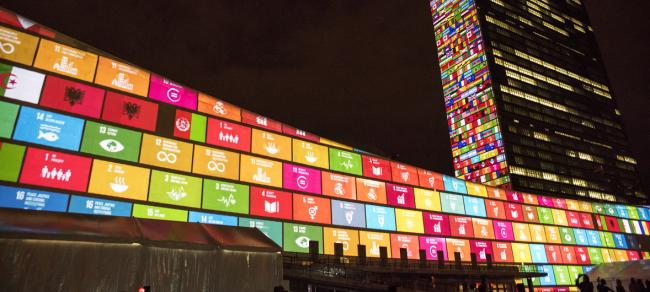
Financing the 2030 Agenda: What is it and why is it important?
New York, Sept 25 (IBNS): António Guterres launches his strategy to finance the 2030 Agenda to put the world on a more sustainable path, this 24 September, ahead of the General Assembly’s annual general debate.
How high on the Secretary-General’s to-do list is the 2030 Agenda for Sustainable Development?
Well, the timing of the meeting to discuss financing the Agenda might be a clue: it takes place on Monday afternoon, just before the General Debate of the General Assembly on Tuesday morning, when the eyes of the world will be on UN Headquarters in New York.
A plan to transform the world
The 2030 Agenda for Sustainable Development, commonly referred to as the 2030 Agenda, is being billed as a plan to “Transform Our World.”
In 2015, UN Member States adopted the Agenda and its 17 Sustainable Development Goals, or SDGs, which break down into three broad areas: people, planet and prosperity.
The adoption of the Agenda was significant, as it was the first time that world leaders pledged common action in support of such a universal and ambitious policy agenda. As the name suggests, the organizing principle of the Agenda and the SDGs, is sustainable development, and this is also the key message to the world community.
The UN defines sustainable development as “development that meets the needs of the present, without compromising the ability of future generations to meet their own needs.” This means taking into account, for example, the effects that unbalanced economic growth can have on the environment and people’s wellbeing.
The SDGs provide a framework for sustainable development that improves the lives of everyone, everywhere. For example, ensuring that economies grow and provide decent work; that everyone has access to nutritious food, no matter where they live; and access to quality education for all.
From 2015 until 2030, Member States, civil society and other partners are mobilizing efforts to change the way the world does business: ending all forms of poverty, fighting inequalities and tackling climate change, while ensuring that no one is left behind.
Since 2015, the UN has been hosting several meetings every year, designed to monitor the progress of Member States and partners, including the private sector, in changing business practices to ensure that the SDGs can be met.
The foundations for the financing of the SDGs were laid in July of that year, at the Third International Conference on Financing for Development, which took place in the Ethiopian Capital Addis Ababa, in a document called the Addis Ababa Action Agenda. It provided a new global framework for financing sustainable development by aligning finance with economic, social and environmental priorities; and set out a list of over 100 concrete measures, touching on finance, technology, innovation, trade, debt and data, in order to reach the SDGs.
Progress and setbacks
Since then, there have been positive signs. Just a week ago, at the Global Climate Action Summit, it was estimated that new UN-backed commitments to take action against the damaging effects of climate change could result in $26 trillion in economic benefits worldwide, and help create 65 million new “low-carbon jobs” by 2030.
Many welcome initiatives by governments and companies were noted. For examples, the Investors Agenda, one of the focus areas of the Global Climate Action Summit, brought together nearly 400 investors, managing $32 trillion of assets, who pledged to scale up the flow of capital into climate action, and a more sustainable, low-carbon economy.
However, whilst this new way of running the world presents a huge investment opportunity, public or private resources, and investments remain stubbornly far below what is needed to meet the 2030 targets.
Too much investment remains short-term and volatile, and the systemic change needed transform economies and societies is not yet happening. Governments need to make it easier for business to finance and invest in sustainable development projects, the private sector needs to mobilize for long-term investment, and new solutions for financing the SDGs must be created.
The High-Level Meeting on Financing the 2030 Agenda
Which brings us back to Monday’s meeting. It can be expected that the timing, and the senior status of politicians taking part, will ensure that considerable attention will be directed to the proceedings, and the outcome.
The Secretary-General will open the meeting, followed by Christine Lagarde, the Managing Director of the International Monetary Fund (IMF). Heads of State and Government will also participate, as well as senior representatives of leading private sector investors, financial technology innovators, and foundations.
Guterres has indicated that this meeting will be used to build momentum and political support at all levels; step up engagement with the private sector; and make the most of innovative solutions to finance the SDGs.
It will also be the forum for the launch of his Strategy for Financing the 2030 Agenda for Sustainable Development, which has three objectives:
1. Aligning global financial and economic policies with the 2030 Agenda
2. Enhancing sustainable financial strategies at the regional and country levels
3. Exploiting the potential of financial innovations, new technologies and digitalization to provide equitable access to finance.
After the meeting, the process continues, with several follow-ups scheduled for this year, and into 2019. The road is long, complicated and filled with potential potholes, but the commitment from the UN is clear: transform the world for the better by 2030.
Support Our Journalism
We cannot do without you.. your contribution supports unbiased journalism
IBNS is not driven by any ism- not wokeism, not racism, not skewed secularism, not hyper right-wing or left liberal ideals, nor by any hardline religious beliefs or hyper nationalism. We want to serve you good old objective news, as they are. We do not judge or preach. We let people decide for themselves. We only try to present factual and well-sourced news.







